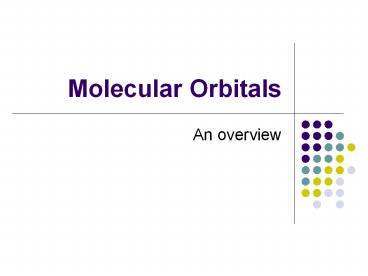Molecular Orbitals - PowerPoint PPT Presentation
Title:
Molecular Orbitals
Description:
Molecular Orbitals An overview MO Theory Robert Mullikan won the Nobel Prize in 1966 for developing this theory. This theory describes the electrons in orbitals ... – PowerPoint PPT presentation
Number of Views:566
Avg rating:3.0/5.0
Title: Molecular Orbitals
1
Molecular Orbitals
- An overview
2
MO Theory
- Robert Mullikan won the Nobel Prize in 1966 for
developing this theory. - This theory describes the electrons in orbitals
belonging to the entire molecule.
3
Molecular Orbitals
- A molecular orbital (MO) can hold a maximum of
two electrons. - A MO has a definite energy.
- We can represent an MO with an electron-density
cloud.
4
LCAO
- Linear Combination of Atomic Orbitals
- Whenever two atomic orbitals overlap, two
molecular orbitals form. - in out
- Energy is conserved, so
- One orbital will be lower in energy
- One orbital will be higher in energy
5
The Hydrogen Molecule
6
The Two Orbitals
- s Antibonding orbital
- Very little electron density between the nuclei
- Higher in energy
- Destabilizes bond formation
- s Bonding orbital
- Promotes bond formation
- Electron density is between the nuclei
- Lower in energy
7
Bonding and Antibonding Orbitals
8
MO Diagrams
9
H2 and He2
10
Complex MO Diagrams
11
Bond Order
- In MO theory, bond stability of a covalent bond
is related to its bond order. - Bond order ½( bonding electrons -
antibonding electrons) - Bond order can be an integer or a fraction
Bond Order of bonds
0 No bond exists
1 Single bond
2 Double bond
3 Triple bond
12
Calculate Bond Order for He2
13
Compare bond orders
- Which would be more stable He2 or He2?
Justify your answer.































